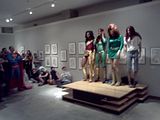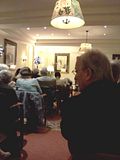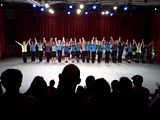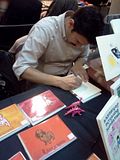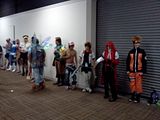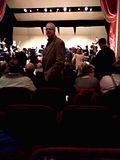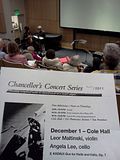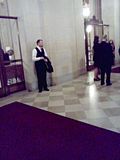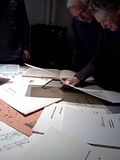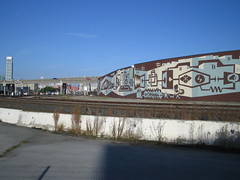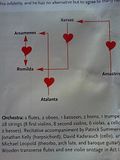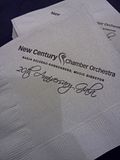
Last week I attended the big
Adler Fellows Gala Concert, & all the
singers seemed determined to give us their biggest & best. The lengthy program started at 7:30p, but it wasn't until 7:55p that we heard the 1st singer, baritone
Ao Li, in an aria from
Cenerentola. I liked the pleasing ring to his voice & his happy, open face. Tenor
Daniel Montenegro does not have a huge voice, but his sound is dark & velvety, & he was a dreamy Des Grieux & Roméo. Soprano
Nadine Sierra makes a luscious sound & she got a warm response to her scene from
Lucia. She sang clear trills, & her high notes were never forceful. The audience also clearly approved of her & mezzo
Maya Lahyani in the Presentation of the Rose scene from
Der Rosenkavalier. Ms. Lahyani has a wonderfully full, grounded sound & was convincingly masculine. I enjoyed her even more when she returned as a dramatically focused Didon in a scene from
Les Troyens.
Soprano
Sara Gartland got a big ovation for her slinky
Thaïs. Both her high notes & her acting were assertive & secure. Soprano
Susannah Biller sang Zerbinetta's coloratura aria while she paced the stage with big gestures & flirted with the conductor. Her high notes were bright & confident, & she received appreciative applause from the orchestra. Tenor
Brian Jagde, in his one short aria from
Werther, got cheers for his brawny singing & belting high notes. Soprano
Leah Crocetto has a sturdy voice with an exciting tension to it. She sang her aria from
Maometto II with control, at one point hitting a beautiful high note that seemed to come out of nowhere. She was even more impassioned in a scene from
Luisa Miller in which her powerful voice filled the hall. The audience was so excited that they spontaneously applauded mid-scene.
The
San Francisco Opera Orchestra played brilliantly. The strings were tight in the
William Tell Overture, & there were lovely clarinet & oboe solos in the
Der Rosenkavalier excerpt. I liked the alert & precise piano playing during the
Ariadne scene. From my seat in the top row of the balcony the bass drum, timpani & basses sounded like they were right in my face. Conductor
Giuseppe Finzi led with roomy tempos that were never pressing. His left hand seems to either float at his side or mirror his right hand. The audience of avid Adler fans gave the concert an immediate standing ovation.
§ The Future is Now: Adler Fellows Gala Concert
San Francisco Opera Orchestra
Conductor: Giuseppe Finzi
Guillaume Tell, Rossini
Overture
La Cenerentola, Rossini
"Come un ape ne' giorni d'Aprile"
Dandini: Ao Li
Manon, Massenet
"Instant charmant...en fermant les yeux"
Des Grieux: Daniel Montenegro
Lucia di Lammermoor, Donizetti
"Regnava nel silenzio"
Lucia: Nadine Sierra
Le Nozze di Figaro, Mozart
"Tutto è disposto...Aprite un po' quegl' occhi"
Figaro: Ryan Kuster
Maometto II, Rossini
"Giusto ciel"
Anna: Leah Crocetto
Theodora, Handel
"To thee, thou glorious son of worth"
Theodora: Susannah Biller; Didymus: Ryan Belongie
David Hanlon, harpsichord
Der Rosenkavalier, Strauss
"Mir ist die ehre"
Sophie: Nadine Sierra; Octavian: Maya Lahyani
Don Pasquale, Donizetti
"Pronta io son"
Norina: Sara Gartland; Malatesta: Ao Li
Tancredi, Rossini
"Oh patria...Tu che accendi...Di tanti palpiti"
Tancredi: Ryan Belongie
Les Troyens, Berlioz
"Je vais mourir"
Didon: Maya Lahyani
Thaïs, Massenet
"Me voilà seule...Dis-moi que je suis belle"
Thaïs: Sara Gartland
Roméo et Juliette, Gounod
"L'amour...Ah, lève-toi soleil!"
Roméo: Daniel Montenegro
Ariadne auf Naxos, Strauss
"Grossmächtige prinzessin"
Zerbinetta: Susannah Biller
Tamara Sanikidze, piano
Werther, Massenet
"Toute mon âme est là...pourquoi me réveiller?"
Werther: Brian Jagde
Luisa Miller, Verdi
"Il padre tuo...Tu puniscimi"
Luisa: Leah Crocetto; Wurm: Ryan Kuster
Guillaume Tell, Rossini
"Tout change et grandit en ces lieux"
Tutti
Thursday, December 1, 7:30pm
Herbst Theatre, War Memorial Veterans Building
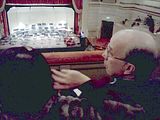 The San Francisco Chamber Orchestra had a full house for their meaty all-Beethoven program at Herbst on Friday night. The Coriolan Overture had snap. The hammer-blow chords, as well as the silences between, were precise, with clean cut-offs. The 1st violins played strongly. The audience clapped tenatively after the Overture's soft ending but applauded every movement after that. Conductor Benjamin Simon led a vigorous performance of Beethoven's 2nd Symphony which emphasized tight articulation & strong accents. He made a clear contrast between the active 1st movement & the more legato 2nd movement. There were nice flute & bassoon solos, & I liked the dialogue between the strings & the bassoon in the 2nd movement. The final movement was rollicking & high-spirited & made me think of Rossini.
The San Francisco Chamber Orchestra had a full house for their meaty all-Beethoven program at Herbst on Friday night. The Coriolan Overture had snap. The hammer-blow chords, as well as the silences between, were precise, with clean cut-offs. The 1st violins played strongly. The audience clapped tenatively after the Overture's soft ending but applauded every movement after that. Conductor Benjamin Simon led a vigorous performance of Beethoven's 2nd Symphony which emphasized tight articulation & strong accents. He made a clear contrast between the active 1st movement & the more legato 2nd movement. There were nice flute & bassoon solos, & I liked the dialogue between the strings & the bassoon in the 2nd movement. The final movement was rollicking & high-spirited & made me think of Rossini.





